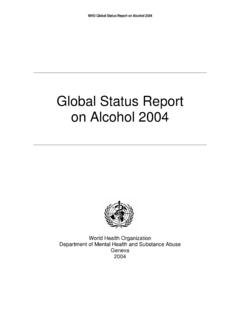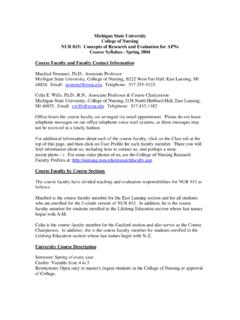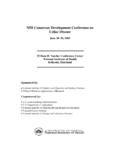Transcription of SCIENTIFIC DISCUSSION This module reflects the …
1 1/22 EMEA 2004 SCIENTIFIC DISCUSSION this module reflects the initial SCIENTIFIC DISCUSSION for the approval of Forsteo. For information on changes after approval please refer to module 8. 1. Introduction Osteoporosis is a systemic disorder characterised by decreased bone mass and microarchitectural deterioration of bone tissue leading to bone fragility and increased susceptibility to fractures of the hip, spine and wrist. Osteoporosis affects an estimated 75 million people in Europe, United States and Japan combined. Osteoporotic fractures represent a major health problem. Within the past few years several antiresorptive therapies have been introduced.
2 These include biphosphonates, hormone replacement therapy, selective oestrogen receptor modulators and calcitonin. FORSTEO was developed to stimulate the bone formation. It contains teriparatide, a recombinant 1-34 N-terminal fragment of endogenous human parathyroid hormone (rhPTH(1-34)). 84-amino acid parathyroid hormone (PTH) stimulates the bone formation by direct effects on bone-forming cells (osteoblasts) increasing intestinal absorption of calcium and excretion of phosphate and increasing intestinal absorption of calcium via its effects on 1,25 dihydroxyvitamin D production. It is indicated for the treatment of established osteoporosis in postmenopausal women.
3 A significant reduction in the incidence of vertebral, but not hip fractures has been demonstrated. The recommended dose is 20 micrograms once daily administered subcutaneous. 2. Part II: Chemical, pharmaceutical and biological aspects Composition The finished product is formulated as a multi-dose small volume parenteral containing a % w/v aqueous solution of teriparatide (20 g/80 l dose) in acetate buffer pH 4, preserved with % w/v metacresol. It is presented in a 3 ml cartridge assembled into a disposable product-dedicated pen-injector that contains treatment for 28 days. The pen-injector is identical to that approved for Humalog-Pen in June 1997 (EU/1/97/0042/001), with the exception of injection volume and dose display.
4 The product does not contain ingredients of animal or human origin. Active substance The active substance, teriparatide, is the 1-34 N-terminal fragment ( Da, as calculated) of endogenous human parathyroid hormone (rhPTH(1-34), produced in E. coli using recombinant DNA technology. The amino terminus is critical for G-protein linked stimulation of adenylate cyclase that catalyses the formation of second messengers such as cAMP that activates the desired biological effects by phosphorylation of critical intracellular proteins. Development genetics and cell bank system Teriparatide is produced in a transformed non-pathogenic E.)
5 Coli K12 strain. Construction of the recombinant gene and production host/vector is described in detail. Production of the Master Cell Bank (MCB) and Working Cell Bank (WCB) is adequately described. Characterisation testing of the cell banks was carried out in accordance with ICH Guideline Q5D. All test results demonstrate a pure and stable host/vector system through or beyond the end of production cycle. Production and purification The active substance is manufactured by Eli Lilly and Company, Indianapolis, USA. 2/22 EMEA 2004 Several process optimisations occurred during development, designated Process I, II, IIIa, IIIb and IIIc (commercial process), with no changes in manufacturing site.
6 The consistency of the impurity profile of commercial lots (Process IIIc) compared to pre-clinical/clinical lots manufactured by earlier processes (Process I IIIb) has been demonstrated by comparative RP-HPLC chromatograms. Moreover, the commercial process was used to manufacture batches used in late Phase III clinical trials. The fermentation and isolation process have been adequately described in the application. The isolated materials are held at not more than -10 C until further processing. In-process controls assure appropriate cell growth, product synthesis and the absence of microbial or phage contamination.
7 Specifications for raw materials and a description of cell culture media and equipment have been provided. No human or animal sourced raw materials are used in processing. The process has been validated and the data indicate that the manufacturing process consistently meets in-process specifications and control ranges. The rhPTH(1-34) purification process has been comprehensively described in the application and consists of several chromatographic separations, tangential flow filtrations, chemical reactions and a final freeze drying step. In-process controls assure appropriate purity. Specifications for raw materials have been provided.
8 No human or animal sourced raw materials are used in processing. The process has been validated and the data indicate that the manufacturing process consistently meets in-process specifications and control ranges. Additionally, validation addressed the removal of process and product related impurities and stability of process intermediates. Characterisation of the active substance rhPTH(1-34) is a single chain peptide containing 34 amino acids with a molecular mass of Da. The peptide is highly flexible, with transient helical regions. Full characterisation of the active drug substance has been performed on a primary in house reference standard (RS0265).
9 Physico-chemical characteristics, primary, secondary, tertiary and quaternary structure of rhPTH(1-34) were evaluated and appropriately documented. The biological potency is characterised by a cell-based assay which relies upon the ability of rhPTH (1-34) to stimulate cAMP production in a cell line expressing PTH receptors. Analytical development rhPTH(1-34) specific methods were developed at Eli Lilly and Company. Validation of all product specific analytical methods is described in detail, the reference standards used are fully documented. Impurities The data presented by the applicant demonstrate the capacity of the purification process to effectively remove product as well as process related impurities.
10 Batch Results Batch data for all batches used in pre-clinical, toxicology and clinical trials and three recent validation lots manufactured according to the commercial process demonstrate compliance with the specifications. Stability of the active ingredient The company has provided updated drug substance stability data for three pilot-scale (primary stability lots) and three full-scale lots. The data provided indicates acceptable stability of the drug substance for the proposed shelf life. Other ingredients Excipients meet Ph. Eur. Monographs, where available (metacresol: USP). A certificate of analysis is provided for the 35% silicone emulsion.















